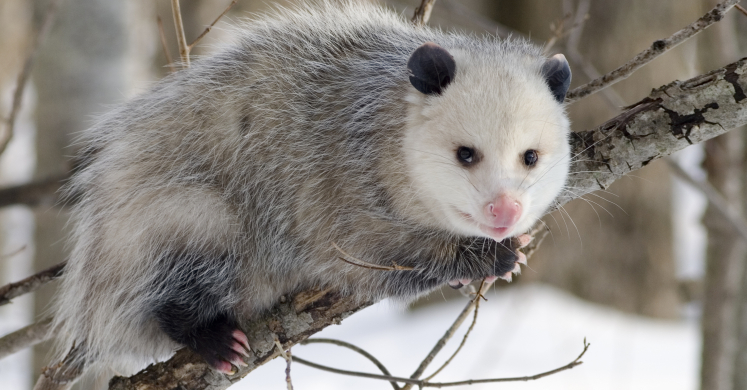Blog

#bioPGH Blog: Playin’ Possum
 A resource of Biophilia: Pittsburgh, #bioPGH is a weekly blog and social media series that aims to encourage both children and adults to reconnect with nature and enjoy what each of our distinctive seasons has to offer.
A resource of Biophilia: Pittsburgh, #bioPGH is a weekly blog and social media series that aims to encourage both children and adults to reconnect with nature and enjoy what each of our distinctive seasons has to offer.
This week included a celebration of love (and the day-after chocolate sales!), but while the human world was in the bubbly cloud of roses and heart-shaped notes, a slightly different animal was also preparing its best courtship plans as well: the Virginia opossum. Our local marsupial’s mating season begins late February, and male suitors will need to offer the best-sounding clicks as a courtship call to attract the discerning females. Perhaps not a violin serenade, but it’s the perfect quirky song for a quirky nighttime creature. Let’s learn a bit more about our quirky neighbors!
First of all, our local Virginia opossums (Didelphis virginiana) carry the distinction of being North America’s only marsupial. This means that females have a pouch and give birth to highly underdeveloped babies that are about the size of jelly beans, and the babies will finish their development in said pouch. For opossums, this means living about 8-10 weeks in the pouch (starting soon in March) and emerging in late spring. Some female opossums will go on to have a second litter later in the year, usually in May – July.
Another thing that is fascinating about opossums is their bite! Opossums have a bite force of roughly 45 pounds per square inch. By comparison, the average human produces a bite force of approximately 160 pounds per square inch, but remember, little opossums only weigh an average 8 – 15 pounds! Opossums also have 50 teeth, the most of any North American land animal. Would an opossum ever bite a human? Well, anything with a mouth can bite, but an opossum has very little cause to bite you. They don’t want to be that close to you!
Rather than worrying about their bite, most of us are familiar with opossums’ quirky self-defense act of “playing dead.” This act has a few layers to it, though. As a first line of defense, an opossum will usually simply freeze in place with their head down and eyes open, following the threat. If the threat escalates, opossums may behave aggressively and hiss, but if that doesn’t work, then comes the real show: apparent death, also called tonic immobility. Their body stiffens, heart rate drops, breathing slows and they often defecate and drool. Even when touched or investigated by a threat (usually a predator), they don’t move or respond. Their bodies are actually paralyzed. Usually, this is enough to dissuade a hungry predator about the meal. Who wants a stinky, drooly dinner, after all? After the threat has dissipated, the opossum will “wake up” and go back about his day. The truly fascinating part of this behavior is actually involuntary — a reflex to an extreme threat — yet the opossum is at least somewhat conscious throughout the paralysis. When humans experience a similar stress-induced reflex response, we know it as fainting, and we are unconscious for that. Opossums seem to be able to identify when the threat has passed, as indicated changing heart rates in the presence and absence of potential predators while “playing possum.”
One cool story about opossums, though, is related to a meme you may have seen on social media. Many of us have heard that oppsums eat ticks — possibly as many as 5,000 ticks per possum per year or season, depending on the source. A few years ago, though, a student and a professor at Eureka College wanted to get to the bottom of that popular stat, and launched a study on possum diets. They looked at both gut contents and searched the literature for other papers and realized that ticks really weren't a major source of possum diets at all. The source of confusion had been a single lab study that had been quoted probably beyond intent and with little follow-up. What I love about this study (and thanks to our horticulture director for finding!) is that a student heard an often-quoted statistic and just couldn't make sense of it, so she set out to find the real answer with her professor supporting her inquisitive efforts. And they made a surprising find! So let's hear it for women in science who are ready to keep exploring our world!
For all of their quirkiness, though, and regardless of whether or not they eat ticks en masse, opossums really are an important part of their habitats. Opossums are also unlikely to spread most diseases that we humans fear from wildlife like rabies because their body temperatures are too low. So let's give our misunderstood friends a round of applause and a safe viewing distance.
Connecting to the Outdoors Tip: Since our local Virginia opossum is nocturnal, your best chance for seeing them is usually at night. If you come across one around your trash bin or backyard, don’t worry, just give them space and they will avoid you as best they can.
Resources
National Wildlife Federation – Opossums: Unsung Heroes in the Fight Against Ticks and Lyme Disease
Alboni and Alboni 2014: Origin and Evolution of the Vasovagal Reflex
#bioPGH Blog: Spring Baby Boom!
#bioPGH Blog: The Secrets of Skulls
Select photos © Tony Pope CC-BY-SA-2.5

